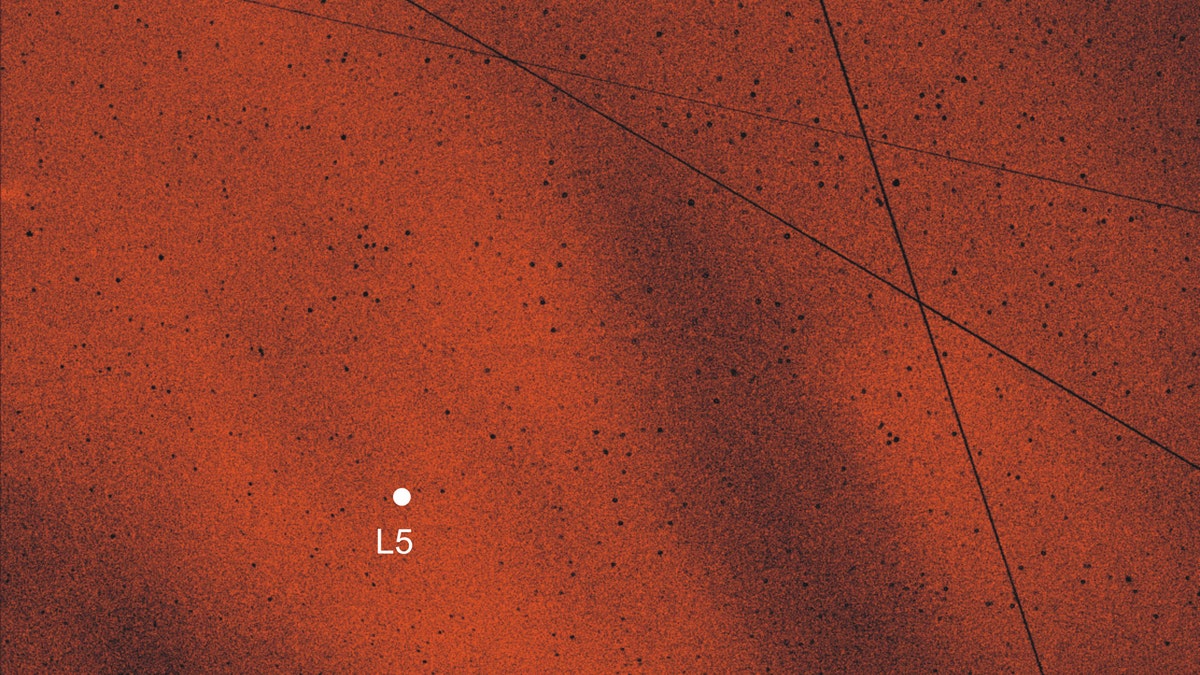
Pattern of the angle of polarization of the sky around the L5 Lagrange point of the Earth-Moon system, measured by imaging polarimetry in the green (550 nm) spectral range at 01:14:15 UT on 19 August 2017. The position of the L5 point is shown by a white dot. In this picture the central region of the Kordylewski dust cloud is visible (bright red pixels). The straight tilted lines are traces of satellites. (Credit: J. Slíz-Balogh)
Talk about dust bunnies you can't get rid of.
A new study may finally confirm the reality of dust clouds that have circled the Earth, after scientists have had heated debates over their existence for more than 50 years.
The clouds were first spotted by Polish astronomer Kazimierz Kordylewski in 1961, near the L5 Lagrange point, according to Space.com. Lagrange points are five points in deep space where the gravitational pull between the Earth and Moon balance each other out, explains Space.com. Two of these, L4 and the aforementioned L5, form "an equal-sided triangle" with the Earth and the Moon and move around the Earth as the Moon goes through its lunar orbit.
NASA POSTS PHOTO OF CRASHED 'FLYING SAUCER FROM OUTER SPACE'
"L4 and L5 are not completely stable, as they are disturbed by the gravitational pull of the Sun," researchers said in a statement. "Nonetheless they are thought to be locations where interplanetary dust might collect, at least temporarily. Kordylewski observed two nearby clusters of dust at L5 in 1961, with various reports since then, but their extreme faintness makes them difficult to detect and many scientists doubted their existence."
One of the study's authors, Judit Slíz-Balogh, said the clouds were difficult to find, despite being close to our planet, cosmically speaking.
“The Kordylewski clouds are two of the toughest objects to find, and though they are as close to Earth as the Moon are largely overlooked by researchers in astronomy," Slíz-Balogh said in the statement. "It is intriguing to confirm that our planet has dusty pseudo-satellites in orbit alongside our lunar neighbor.”
The triangular Lagrange points were discovered in 1772, according to the study's abstract.
Because of how faint they are, they need certain weather conditions in order to prove they exist, Gábor Horváth, the study's co-author, told Space.com. But Horváth and Slíz-Balogh developed computer models to see whether they reflected light and see how they formed, which ultimately led to them confirming their existence.
MYSTERiOUS INTERSTELLAR OBJECT COULD BE 'LIGHTSAIL' FROM ANOTHER CIVILIZATION
Noting that few models have studied the Kordylewski dust cloud, the researchers said they filled the gap by investigating "a three-dimensional four-body problem consisting of the Sun, Earth, Moon and one test particle, 1 860 000 times separately. We mapped the size and shape of the conglomerate of particles that have not escaped from the system sooner than an integration time of 3650 d around L5."
Researchers need to study the dust clouds to see if they present "any kind of threat to equipment and future astronauts."
As time goes on, the researchers said they believe that the L4 and L5 points could be "potential sites for orbiting space probes, and as transfer stations for missions exploring the wider Solar System," as well as being places to store pollutants.
Even in space, people are still trying to sweep the dust under the rug.
Follow Chris Ciaccia on Twitter @Chris_Ciaccia




















